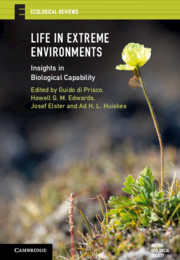Book contents
- Life in Extreme Environments
- Ecological Reviews
- Life in Extreme Environments
- Copyright page
- Dedication
- Contents
- Contributors
- Introduction
- Part I Extreme environments: responses and adaptation to change
- Part II Biodiversity, bioenergetic processes, and biotic and abiotic interactions
- Part III Life in extreme environments and the responses to change: the example of polar environments
- Chapter Seven Life in the extreme environments of our planet under pressure
- Chapter Eight The ecophysiology of responding to change in polar marine benthos
- Chapter Nine The Southern Ocean: an extreme environment or just home of unique ecosystems?
- Chapter Ten Microorganisms in cryoturbated organic matter of Arctic permafrost soils
- Chapter Eleven Chemical ecology in the Southern Ocean
- Chapter Twelve Metabolic and taxonomic diversity in antarctic subglacial environments
- Part IV Life and habitability
- Index
- Plate Section (PDF Only)
- References
Chapter Eight - The ecophysiology of responding to change in polar marine benthos
from Part III - Life in extreme environments and the responses to change: the example of polar environments
Published online by Cambridge University Press: 28 September 2020
- Life in Extreme Environments
- Ecological Reviews
- Life in Extreme Environments
- Copyright page
- Dedication
- Contents
- Contributors
- Introduction
- Part I Extreme environments: responses and adaptation to change
- Part II Biodiversity, bioenergetic processes, and biotic and abiotic interactions
- Part III Life in extreme environments and the responses to change: the example of polar environments
- Chapter Seven Life in the extreme environments of our planet under pressure
- Chapter Eight The ecophysiology of responding to change in polar marine benthos
- Chapter Nine The Southern Ocean: an extreme environment or just home of unique ecosystems?
- Chapter Ten Microorganisms in cryoturbated organic matter of Arctic permafrost soils
- Chapter Eleven Chemical ecology in the Southern Ocean
- Chapter Twelve Metabolic and taxonomic diversity in antarctic subglacial environments
- Part IV Life and habitability
- Index
- Plate Section (PDF Only)
- References
Summary
Environments vary over all spatial scales, from subatomic to the universe and all timescales from a Plank unit to eternity. There have been very large changes in environments in the past, notably over hundreds to thousands of years during glaciations driven by Milankovitch cycles (Zachos et al., 2001). Life on Earth has survived and evolved over time to adapt to those changes and to exploit nearly all of the available environments on Earth. The very small exceptions include the insides of hydrothermal vents
- Type
- Chapter
- Information
- Life in Extreme EnvironmentsInsights in Biological Capability, pp. 184 - 217Publisher: Cambridge University PressPrint publication year: 2020

